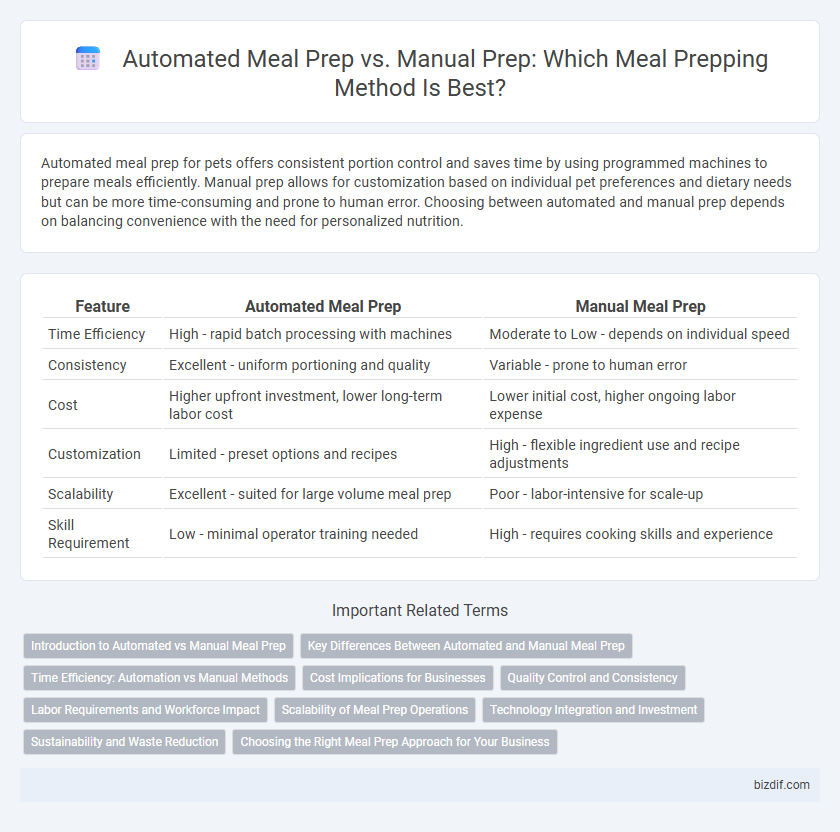Automated meal prep for pets offers consistent portion control and saves time by using programmed machines to prepare meals efficiently. Manual prep allows for customization based on individual pet preferences and dietary needs but can be more time-consuming and prone to human error. Choosing between automated and manual prep depends on balancing convenience with the need for personalized nutrition.
Table of Comparison
| Feature | Automated Meal Prep | Manual Meal Prep |
|---|---|---|
| Time Efficiency | High - rapid batch processing with machines | Moderate to Low - depends on individual speed |
| Consistency | Excellent - uniform portioning and quality | Variable - prone to human error |
| Cost | Higher upfront investment, lower long-term labor cost | Lower initial cost, higher ongoing labor expense |
| Customization | Limited - preset options and recipes | High - flexible ingredient use and recipe adjustments |
| Scalability | Excellent - suited for large volume meal prep | Poor - labor-intensive for scale-up |
| Skill Requirement | Low - minimal operator training needed | High - requires cooking skills and experience |
Introduction to Automated vs Manual Meal Prep
Automated meal prep leverages technology and appliances like robotic kitchen tools and smart cookers to streamline ingredient measurement, cooking, and packaging processes, significantly reducing preparation time and human error. Manual meal prep involves hands-on techniques where individuals chop, cook, and portion meals, offering greater control over ingredient choices and customization but often requiring more time and effort. Understanding the comparative efficiencies and flexibility of automated versus manual meal prep helps determine the best approach for nutrition, convenience, and lifestyle needs.
Key Differences Between Automated and Manual Meal Prep
Automated meal prep utilizes machines and technology to streamline food portioning, cooking, and packaging, significantly increasing efficiency and consistency compared to manual meal prep, which relies on human effort for chopping, measuring, and cooking. Key differences include time savings, precision in ingredient measurement, and scalability, with automation reducing human error and labor intensity while manual prep offers greater flexibility and control over customization. Automated systems also minimize long-term costs and waste by optimizing resource use, whereas manual prep requires continuous labor input and may introduce variability in meal quality.
Time Efficiency: Automation vs Manual Methods
Automated meal prep systems significantly reduce preparation time by using advanced machinery to chop, cook, and package meals simultaneously, compared to manual methods that rely on individual tasks performed sequentially. Time efficiency improves with automation as it minimizes human error and decreases downtime between steps, enabling faster turnaround for weekly meal planning. Manual prep requires more hands-on involvement and often leads to longer total prep time due to the repetition of tasks and variability in speed.
Cost Implications for Businesses
Automated meal prep systems significantly reduce labor costs by streamlining ingredient processing and portioning, leading to higher efficiency and lower operational expenses for businesses. Manual meal preparation, while requiring less upfront investment, incurs ongoing labor costs and potential inconsistencies that can affect product quality and scalability. Investing in automation yields long-term cost savings and improved throughput, crucial for businesses aiming to enhance profitability and maintain competitive pricing.
Quality Control and Consistency
Automated meal prep systems utilize precise machinery and standardized processes to ensure consistent portion sizes, cooking temperatures, and ingredient quality, significantly reducing human error and variability. Manual prep relies heavily on individual skill and attention, which can result in fluctuations in texture, flavor, and presentation from batch to batch. Investing in automated solutions enhances overall quality control, guaranteeing uniform meals that meet strict nutritional and safety standards every time.
Labor Requirements and Workforce Impact
Automated meal prep significantly reduces labor requirements by streamlining repetitive tasks through robotics and machine learning, enabling faster portioning and packaging compared to manual prep methods. This reduction in manual labor decreases the need for a large workforce but increases demand for skilled operators to manage and maintain automated systems. Consequently, businesses experience shifts in workforce dynamics, favoring technical proficiency over traditional culinary labor skills.
Scalability of Meal Prep Operations
Automated meal prep systems significantly enhance scalability by enabling consistent portion control and reducing labor costs, facilitating the production of large meal volumes efficiently. Manual meal prep, while flexible for small batches, struggles to maintain uniformity and speed as order sizes increase, limiting operational growth. Investing in automation technology supports expansion in meal prep businesses by streamlining workflows and ensuring reliable output quality at scale.
Technology Integration and Investment
Automated meal prep utilizes advanced robotics and AI software to streamline ingredient sorting, portion control, and cooking processes, significantly reducing human error and labor costs. Manual prep relies heavily on skilled labor and traditional kitchen tools, resulting in higher time investment and variability in meal quality. Investing in automated technology requires upfront capital but enhances scalability, consistency, and data-driven meal customization for long-term operational efficiency.
Sustainability and Waste Reduction
Automated meal prep systems use precise portion control and real-time inventory tracking, significantly reducing food waste compared to manual prep methods. By optimizing ingredient usage and minimizing overproduction, automation supports sustainable kitchen operations and decreases environmental impact. Manual prep, while flexible, often results in inconsistent portions and higher waste levels due to human error and over-preparation.
Choosing the Right Meal Prep Approach for Your Business
Automated meal prep systems enhance efficiency and consistency by utilizing robotics and AI-driven equipment, reducing labor costs and minimizing human error in large-scale food production. Manual prep offers flexibility and customization, allowing chefs to tailor meals to specific dietary needs and maintain artisanal quality, ideal for boutique or niche food businesses. Selecting the right meal prep approach depends on your business scale, customer preferences, production volume, and desired balance between automation benefits and hands-on craftsmanship.
Automated Meal Prep vs Manual Prep Infographic

 bizdif.com
bizdif.com